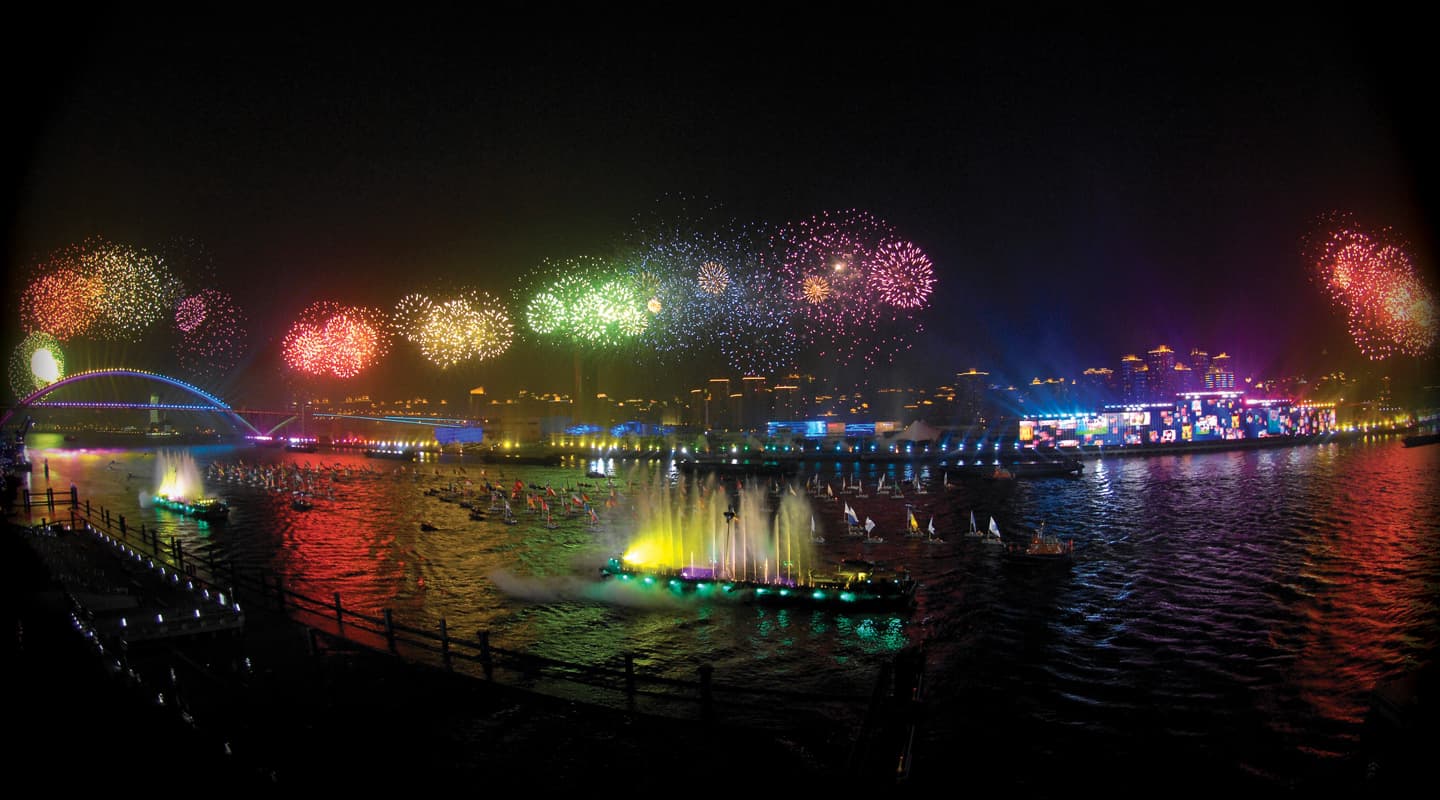
Eye Opener
The Expo 2010 Shanghai Opening Ceremony had it all.Lighting production manager Paul Collison gives us a control room-eye view of the spectacle.
Text & Images:/ Paul Collison
“Bigger than the Olympic Opening Ceremony in Beijing” is how some journalists described the Opening Ceremony of World Expo 2010 in Shanghai. While this may not quite have been the case, it was certainly played over a much bigger area. We’re used to seeing lots of lights and audio in stadia these days, however, something the scale of this event is almost unprecedented. I can certainly say that in my opinion, only a country with the resources of China could pull off a show like this.
There were two main parts to the show. Inside was a completely lavish affair. This was the start of the evening where performances embracing the world’s cultures took place alongside the obligatory protocol moments. A wall of 8mm LED, standing 4m high and spanning the entire 60m width of the stage, created the back drop. More LED, embedded in the vertical facets of the staging helped spread imagery over an even greater area. Over 500 moving lights of all shapes, sizes and brands encompassed the stage, broken up with spherical shapes sympathising with the curved performance stage. Lighting control was via two grandMA(1) consoles.
Outside is where things got crazy. Like some mad exclamation mark at the end of the indoor ceremony, a sound, light, laser, water and firework spectacular took over proceedings.
Let’s start with the ‘performance space’. The Expo site covers an area roughly the size of 1000 football fields. Dwell on that for a moment as you then consider that the Huangpu river, on which the show was centred, averages about 300m in width. The performance space extended between the Lupu Bridge in the West and the Nanpu Bridge on the East, a distance of approximately 2.7km. Even though the entire Expo site was part of the show, with certain key pavilions choreographing their external LED and lighting treatments along with the show, the focus was firmly on the river and the 250m-long LED screen. It’s about now that you should get a rough idea of the size of the project.
SEARCHING FOR SUPERLATIVES
Searchlights were placed every 12.5m on both sides of the river, then continued at a somewhat higher density across each bridge. There were other key locations back from the river where pockets of searchlights were placed. Part of the key focus was, of course, the spectacular China Pavilion with some of the other more prominent buildings employed as lighting positions. The searchlights in question were AutoLT 4kW and 7kW. Locally manufactured in Shenzen, they are particularly durable and reliable fixtures. Agricultural as most searchlights are, the AutoLT fixtures run a CMY colour mixing system, as opposed to the usual gel and scroller arrangement used by others. It’s certainly not a great CMY system. Pastels are near impossible, however the more saturated colours are fine. The AutoLT fixtures may appear to be a little cheap, however, they proved to be an incredibly reliable device; surviving lashing storms, heat waves and sub-zero temperatures. A fault rate of well below 2% is better than most name brands from Europe and the US, particularly when you consider that these fixtures spent almost three months in the elements with absolutely no additional environmental protection.
Enhancing the performance area in front of the VIP areas were 200 Clay Paky 1500W long-throw wash fixtures. Sprinkled around the system, with a higher concentration on the LED screen, were 200 Martin Atomic strobes. Also integrated in the lighting system were the existing architectural LED fixtures on the bridges at either end of the performance space.
Control was via a grandMA2 system. Six control surfaces with Network Processing Units, two-port nodes and NSP (four-port nodes) spread over the site. Fibre optic distribution of MA-Net2 was favoured over a proposed system of wireless ArtNet distribution. This turned out to be a wise decision, given that the energy created by the fireworks actually disrupted the SMPTE broadcast during the show.
Lighting designers Robert Dickinson and Ted Wells, who designed the 30-minute spectacular, were constantly amazed by the talents of the local crew. Every searchlight in the system at some point required a tweaking of the lamp. This task took 20-odd local technicians two nights to accomplish – approximately 480 man-hours – something that would have taken four times as long in any another city.
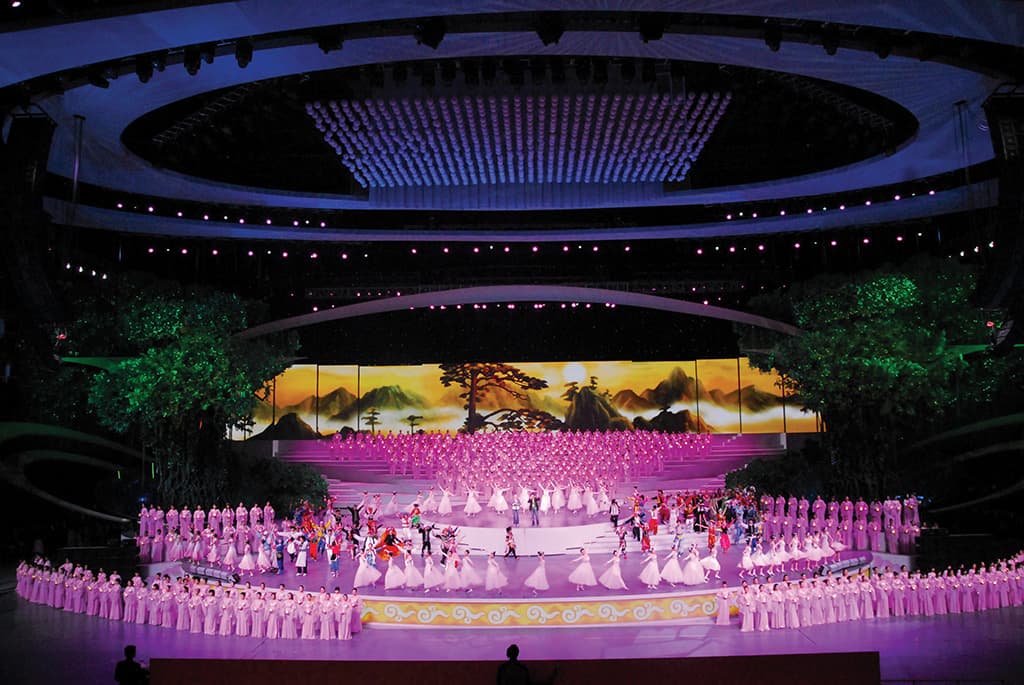
MADE FOR THE BIG SCREEN
Continuing with the big theme, a custom-built LED screen helped deliver the show’s creative narrative. Stepped at three heights from 15m to 25m high in the centre, the screen occupied a whopping 250m along the Puxi side of the river. Pixel pitch was 125mm, and, given that the distance to the VIP area was over 300m, it was more than clear enough for detailed viewing. With content developed by Spinefex of Sydney, the screen at times helped with colour and movement, but also delivered the creative narrative. It was hard to comprehend the size of this screen from any distance. From the public viewing area the screen was, of course, big, but until one got near it, the actual size was difficult to fathom.
ETC Audiovisuel of Paris is often confused with Electronic Theatre Controls Inc. of Madison, Wisconsin – the ETC company that makes lighting fixtures and consoles. This ETC is, in fact, a company with many years experience in large-format projection. Having founded the PIGI art of projection, they are now focused on video control and projection. Fresh from a long stint in Vancouver for the ceremonies at the Winter Olympics, ETC used its proprietary video playback system, OnlyView, to send two HD feeds to the large screen. A station at the control centre allowed the programmer to manage the OnlyView system from the other side of the river via a 4km run of optical fibre.
CRACKER OF A SHOW
If there is a country in the world than can let off some crackers, it is China. Lead by Sydney-based Foti International Fireworks, who has had a presence in China for over 10 years, eight Chinese fireworks companies combined to produce a show that was roughly eight times the size of Sydney’s annual New Year’s Eve display. With dozens of triggering sites to cover, both in the Expo precinct and as far as 5km away at the Pearl Tower, the distribution of timecode for pyrotechnic synchronisation was a major challenge. The solution was to distribute it via three separate wireless networks. FSK (Frequency-Shift Keying) modulated timecode was broadcast over two independent voice-comms channels, while linear (SMPTE) timecode with its higher bandwidth requirement was carried over what was effectively a beefed-up audio distribution system, based around standard in-ear monitoring receivers.
At some points during the show, there were thousands of triggers within a matter of seconds, creating what was one of the most stunning fireworks displays ever witnessed. For the dress rehearsal a few days earlier, roughly 25% of the show was triggered to ensure all would run to plan on the day. Even this display was spectacular.
“”
Outside is where things got crazy
The world’s largest video screen – as seen from behind.
Photograph: Ian Cooper
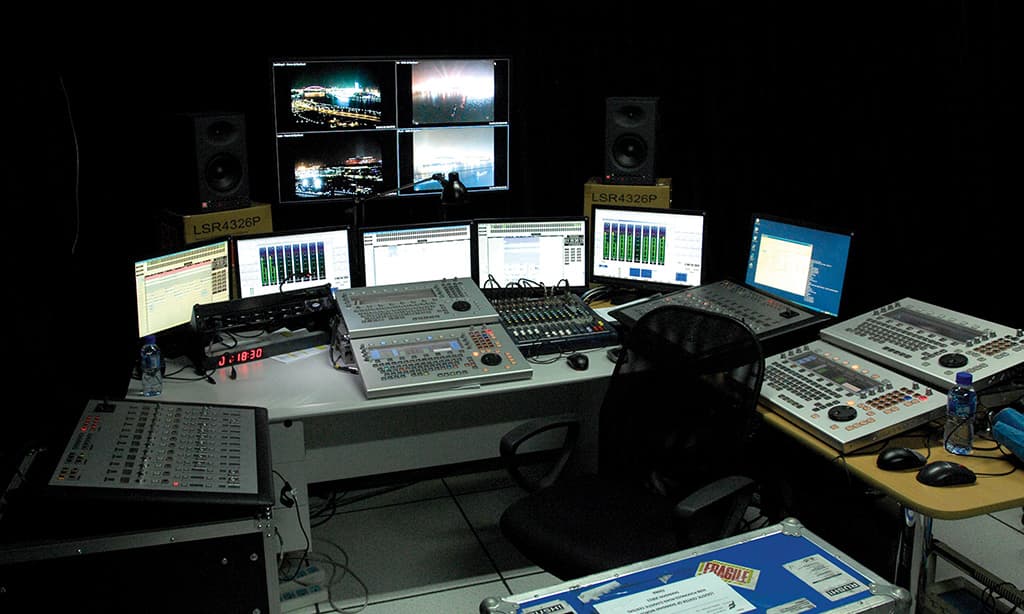
Audio replay control suite with surveillance video screens, redundant pairs of Fairlight Xynergi Media Production Centres, Eclipse talkback station, multiple timecode display unit and OEM speaker mountings.
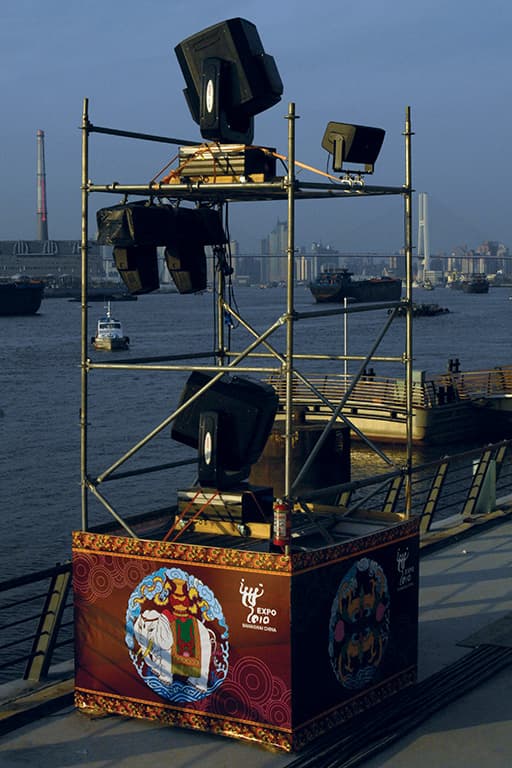
One of the hundreds of riverside towers adorned with AutoLT searchlights, JBL Control 30 loudspeakers, Clay Paky movers with rain hats and the obligatory (but permanently attached) fire extinguisher. Note the extensive use of wooden blocks and ratchet straps for searchlight mounting.
CRITICAL COMMS
On a project of this scale, where crew are distributed over literally hundreds of locations and the technology spread even further, communications are absolutely critical. Following the system specification drafted by project communications consultant Scott Willsallen, the PA People (PAP) from Sydney, which is almost part of the furniture at large-scale events like this, provided all of the communications, both wired and wireless. Its responsibilities extended to the surveillance camera systems, data networks and the site-wide distribution of SMPTE timecode.
Over 900 handheld two-way radios were distributed to almost a dozen contractors. The Clearcom Eclipse matrix system was interfaced to the 32 duplex radio channels required to cover all services. The main Eclipse matrix system was hosted in the Cultural Centre, while a second, fibre-linked Eclipse frame was located at the RF transmission site in an office tower some 2km away. A further 12 key-stations, at five additional locations, were connected into the Eclipse matrix system via IP over the site’s data network, rather than the usual dedicated comms cabling. Despite the complexity of such a large system, actual communication during the event proved to be a simple affair.
To enable stage management, logistics, pyro and lighting, to see parts of the site not visible from the sixth-floor control position in the Expo Cultural Centre, feeds from the site’s 16 surveillance cameras could be monitored via Sony’s Real Shot Manager Advanced software on desktop computers in control and office areas. The PAP data network provided file access, internet, data communications and surveillance across the entire site, from the LED screen to the bowels of the Cultural Centre.
The PA People also brought along its new Ethernet-based multiple time display system. In addition to the usual task of displaying the master timecode coming from the audio replay machines, this system is also capable of a range of other time displays. These included GPS-locked time-of-day for multiple time zones and shared, remote stopwatch timers controlled by stage management. Display units could therefore double as time-of-day and countdown clocks outside of show time, and be located wherever the site data network was available.
BARGE-SCALE WATER EFFECTS
ECA2 of France supplied two water-effect barges affectionately called Man and Woman. Both barges on their own were an impressive display of light, laser, water and projection. They both held various amounts of LED wash fixtures running back to a grandMA(1) Ultra Light console. As well as controlling lighting, the console ran all the water pumps on each barge.
As part of the permanent installation on the Expo site, Aquatique, also of France, has installed a 200m-long water fountain. Usually synchronised to music for a nightly performance, the fountain proved to be a spectacular centrepiece of the Opening Ceremony. Located directly in front of the VIP area, it really placed the spectacular into the laps of the crowd. The combination of valves, articulated hoses and incandescent light sources provided some simple, but effective moments.
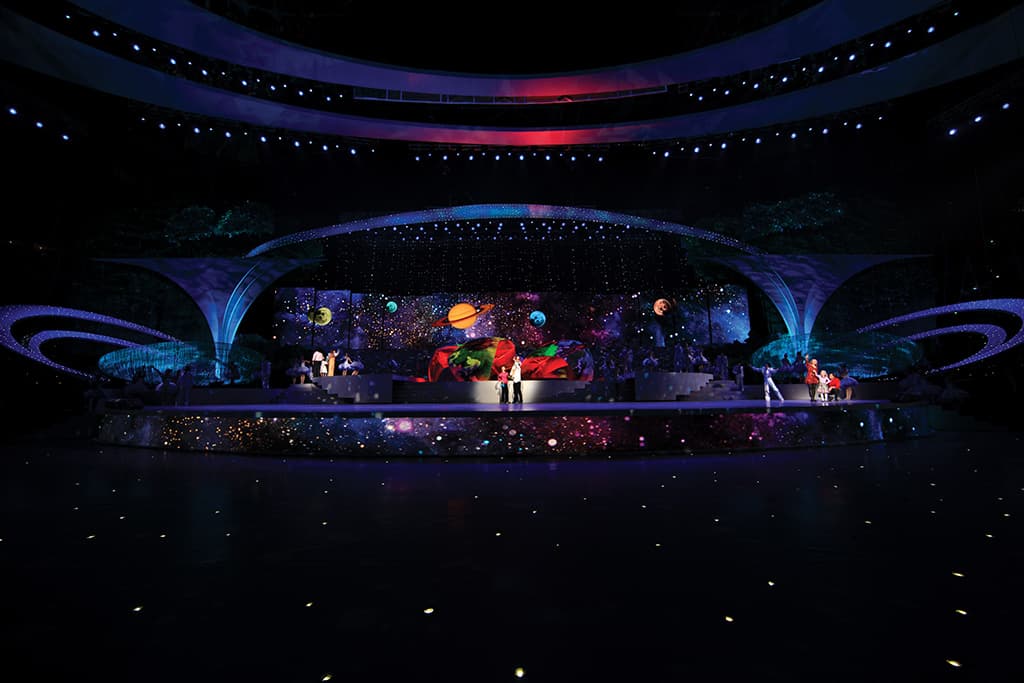
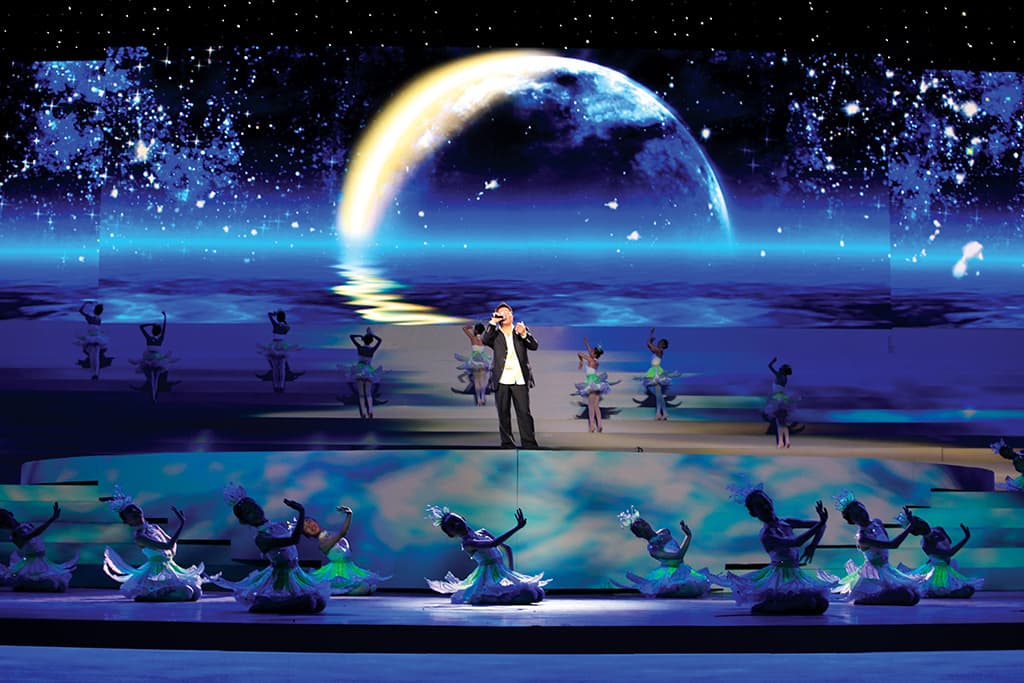
The predominant scenic elements for the Opening Ceremony were video. The backdrop was a 60m wall of 8mm LED, while the floor was covered with projection from four doubled-up pairs of Christie Roadster S+20Ks on the mainstage, four Christie Roadster HD+35Ks on the forestage and a further four Roadster S+20Ks mounted on ZAP yokes for moving effects and special areas.
Courtesy: Wincomm Technology
AUDIO: SONIC BOOM TIME
Multiple levels of redundancy played a huge part in Audio Director, Bruce Jackson’s concept for the event’s audio system, which was supplied and installed by ACE Professional Sound and Lighting. The primary distribution system consisted of a dual-redundant star topology fibre network, carrying MADI data from a Studer Route 6000 (with dual-redundant modules, of course) to Studer D21m distribution racks located at 15 points on both sides of the Huangpu river.
The D21m racks then each distributed AES/EBU (by dual-redundant fibres) to a series of amplifier racks, each of which was managed by a BSS BLU-160 processor.
Each of the BLU-160 processors was then connected to its two nearest neighbours by BLULINK over (dual-redundant) fibres. This then formed a dual-ring-topology BSS-based network linked to BLULINK nodes in the audio control room, that was completely independent of the primary, Studer-based star network. The BSS processors were also linked into the site data network for remote control.
Dual ring networks are widely used because of their ability to maintain connectivity in the face of multiple device and connectivity failures. Combined with an independent dual star network, this 64km fibre distribution system could have maintained audio signal delivery in the face of anything short of multiple direct hits on the Expo site by a cluster of asteroids (Jackson may even have had a plan for that eventuality).
At the 72 amp racks along the river front, each BSS BLU-160 processor fed analogue audio to a stack of Crown XTi-2000 amplifiers that powered their share of the 400 or so JBL Control 30 loudspeakers.
In the VIP area, dual-redundant consoles – a Soundcraft Vi3 and an analogue console – were provided to set local listening levels. Here the Crown amplifiers drove two stacks of 10x JBL Vertec VT4889-1 loudspeakers, with the bottom end provided by 8x JBL VT4880a cabinets.
Main control consisted of dual-redundant Soundcraft Vi6 systems connected to the Studer Route 6000 via MADI, and the secondary BLULINK nodes via AES/EBU. Local monitoring was JBL LSR 4328P loudspeakers.
The primary replay system was an A/B roll pair of Fairlight Xynergi Media Production Centres, each consisting of a Xynergi controller, a CC-1 card in an HP computer and an SX-20 for local audio analogue audio outputs. Main audio outs were connected to the Studer 6000 system via MADI.
The backup replay system was – you guessed it – a dual-redundant pair of Fairlight MPCs. The only difference was that the audio was delivered directly to the backup VIP area console via analogue rather than via the Studer Route 6000.
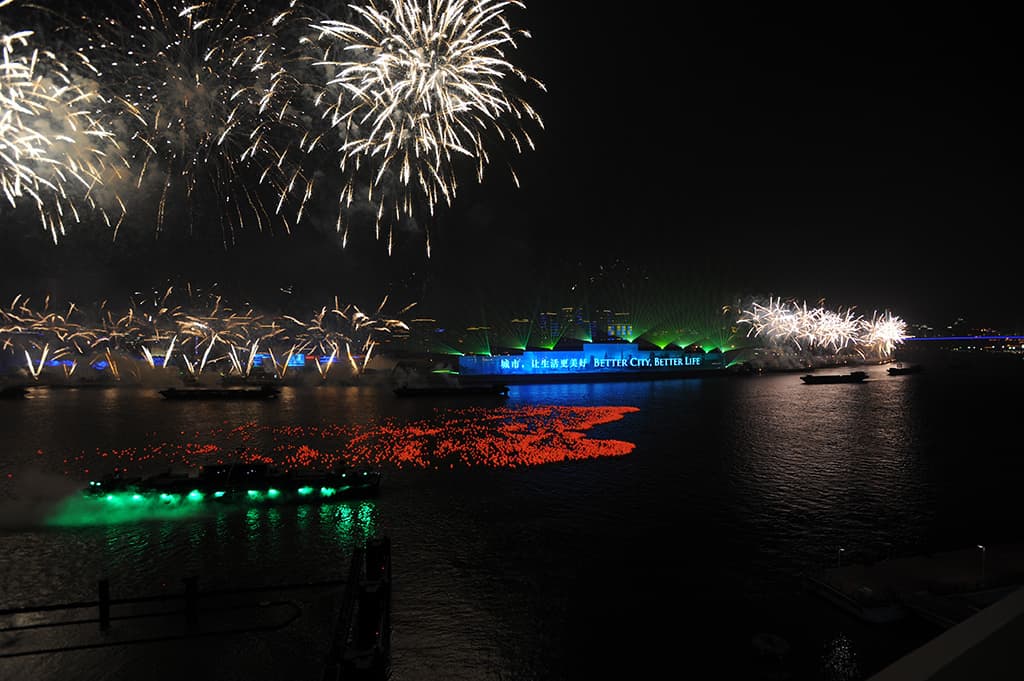
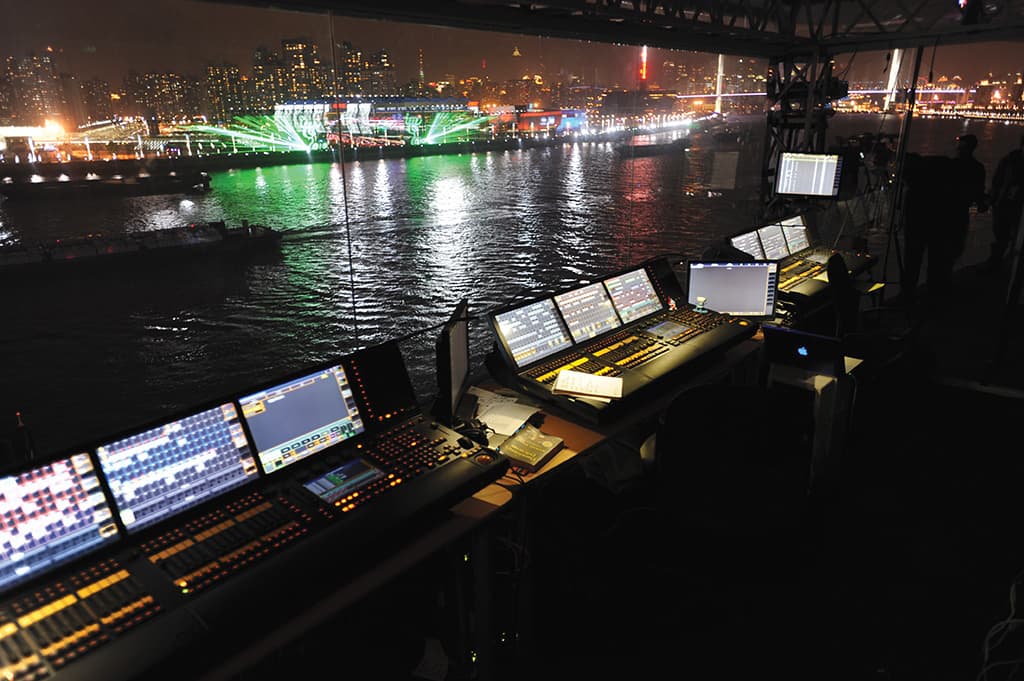
BEST CHINA
Size and scale is something that has been mentioned throughout this article. It’s something that really can’t be underestimated. When there is a fault on a certain piece of gear, and that gear is a 20-minute drive away, faultfinding can be incredibly laborious. Basic things take inordinate amounts of time. The fact that this show ever made it off the ground is a testament to the producers, David Atkins Enterprises. Technical Producer, Richard Martin said “Engineering the world’s largest LED screen and gaining the authorities’ approval to erect it was one of the most challenging, yet satisfying, tasks I have undertaken in 32 years of technical production.”
The project involved an incredible amount of logistics and political management in a relatively short period of time. In something like four months, this project went from concept to fruition. To be the first western company to produce a state event in China is truly a feat on its own. To do it with such success is another entirely.





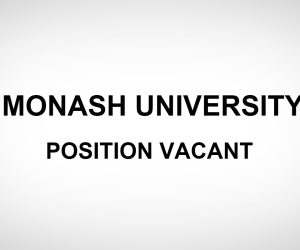









RESPONSES